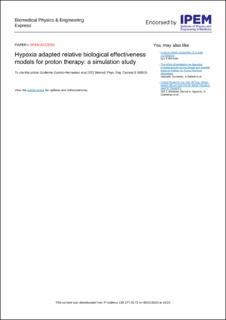| dc.contributor.author | Garrido Hernandez, Guillermo | |
| dc.contributor.author | Henjum, Helge | |
| dc.contributor.author | Høiskar, Marte Kåstad | |
| dc.contributor.author | Dahle, Tordis Johnsen | |
| dc.contributor.author | Redalen, Kathrine | |
| dc.contributor.author | Ytre-Hauge, Kristian Smeland | |
| dc.date.accessioned | 2023-01-17T10:19:22Z | |
| dc.date.available | 2023-01-17T10:19:22Z | |
| dc.date.created | 2022-11-22T19:55:37Z | |
| dc.date.issued | 2022 | |
| dc.identifier.issn | 2057-1976 | |
| dc.identifier.uri | https://hdl.handle.net/11250/3043939 | |
| dc.description.abstract | In proton therapy, a constant relative biological effectiveness (RBE) factor of 1.1 is applied although the RBE has been shown to depend on factors including the Linear Energy Transfer (LET). The biological effectiveness of radiotherapy has also been shown to depend on the level of oxygenation, quantified by the oxygen enhancement ratio (OER). To estimate the biological effectiveness across different levels of oxygenation the RBE-OER-weighted dose (ROWD) can be used. To investigate the consistency between different approaches to estimate ROWD, we implemented and compared OER models in a Monte Carlo (MC) simulation tool. Five OER models were explored: Wenzl and Wilkens 2011 (WEN), Tinganelli et al 2015 (TIN), Strigari et al 2018 (STR), Dahle et al 2020 (DAH) and Mein et al 2021 (MEI). OER calculations were combined with a proton RBE model and the microdosimetric kinetic model for ROWD calculations. ROWD and OER were studied for a water phantom scenario and a head and neck cancer case using hypoxia PET data for the OER calculation. The OER and ROWD estimates from the WEN, MEI and DAH showed good agreement while STR and TIN gave higher OER values and lower ROWD. The WEN, STR and DAH showed some degree of OER-LET dependency while this was negligible for the MEI and TIN models. The ROWD for all implemented models is reduced in hypoxic regions with an OER of 1.0–2.1 in the target volume. While some variations between the models were observed, all models display a large difference in the estimated dose from hypoxic and normoxic regions. This shows the potential to increase the dose or LET in hypoxic regions or reduce the dose to normoxic regions which again could lead to normal tissue sparing. With reliable hypoxia imaging, RBE-OER weighting could become a useful tool for proton therapy plan optimization. | en_US |
| dc.language.iso | eng | en_US |
| dc.publisher | IOP | en_US |
| dc.rights | Navngivelse 4.0 Internasjonal | * |
| dc.rights.uri | http://creativecommons.org/licenses/by/4.0/deed.no | * |
| dc.title | Hypoxia adapted relative biological effectiveness models for proton therapy: a simulation study | en_US |
| dc.type | Journal article | en_US |
| dc.type | Peer reviewed | en_US |
| dc.description.version | publishedVersion | en_US |
| dc.rights.holder | Copyright 2022 IOP Publishing Ltd | en_US |
| dc.source.articlenumber | 065026 | en_US |
| cristin.ispublished | true | |
| cristin.fulltext | original | |
| cristin.qualitycode | 1 | |
| dc.identifier.doi | 10.1088/2057-1976/ac9b5d | |
| dc.identifier.cristin | 2078706 | |
| dc.source.journal | Biomedical Engineering & Physics Express | en_US |
| dc.relation.project | Trond Mohn stiftelse: TMS2019TMT08 | en_US |
| dc.identifier.citation | Biomedical Engineering & Physics Express. 2022, 8 (6), 065026. | en_US |
| dc.source.volume | 8 | en_US |
| dc.source.issue | 6 | en_US |

